The dramatic Woolworth mausoleum in Woodlawn CemeteryÂ
With completion of the Woolworth Building in 1913, the leader of the five-and-dime retail craze Frank W. Woolworth had his grand declaration of success in New York, widely feted and proclaimed.
His hundreds of stores would go on to define the shopping experience around the world over the coming decades. Â (Their lunch counters would also unfortunately typify racial segregation in the 1960s.) While there are no more Woolworth stores in America today*, you can still find many outlets with that brand as far away as Germany and South Africa.
But life took a few unexpected, frequently tragic and often bizarre twists for the Woolworth family over the next few decades following the completion of the Woolworth Building:
Above: The ‘new’ Winfield Hall in 1925. Courtesy Old Long Island
1) Fire at Winfield Hall: While the family enjoyed a very luxurious residence at Fifth Avenue and 80th Street across from the Metropolitan Museum of Art, his wealth was better displayed in the mansion out in Glen Cove, Long Island, where his wife and daughters lived most of the time.
But this house — a wooden, columned manor named Winfield Hall — mysteriously burned down in November 1916.
And just as oddly, Woolworth had almost instantly on hand new plans for a colossal marble palace, more in keeping with the many gigantic homes along Long Island’s Gold Coast.
Think The Great Gatsby of the five-and-dime; in fact, Glen Cove is just a few minutes over from Manhasset, fictionalized by F. Scott Fitzgerald as ‘East Egg’.
The estate is reportedly haunted due, according to sources, to Woolworth’s interest in the occult.
2) Single White Mogul: In 1892, in the early days of Woolworth’s business, he hired a young Brooklyn man, Hubert Parson, as a bookkeeper.
By the 1910s, Parson was Woolworth’s right-hand man, thought of as a part of the family and as the son Frank never had. In 1916, Woolworth shocked many by promoting the relatively young assistant to the role of general manager.
It then appeared that the notoriously vain Parson was attempting to actually outdo his boss, first building a bigger Fifth Avenue mansion than his boss, then, in 1918 purposefully buying a house in Long Branch, New Jersey — named Shadow Lawn — that was far larger than Woolworth’s own Winfield Hall!
“If Woolworth bought a brand new automobile,” writes author Karen Plunkett-Powell, “then Parson would, too — complete with uniformed chauffeur.”
After Frank’s death, Parson would become president of the company. Later in life, he would be criticized for his “extravagant personal lifestyle” during the Great Depression and was eventually forced to retire.
3) Death at the Plaza: Woolworth’s daughter Edna was a tragic and very tormented woman, marrying an associate of her father’s who ended up drinking heavily and cheating on her. In 1917, at the Plaza Hotel, after reading a letter confirming yet another mistress, Edna put on her loveliest lace dress, sat by a window and ingested a lethal dose of poison. Â Unfortunately, her body is discovered several hours later by her daughter Barbara.
4) Why You Should Go to the Dentist: Frank Woolworth had an absolute hatred of going to the dentist, a prejudice that led to his death in April 1919, when he died suddenly due to a tooth infection. Unbelievably, he died with his will unsigned, and all the money (about $30 million) went to his wife Jennie.
However, Jennie was having problems all her own, having been declared ‘mentally feeble‘ and legally incompetent by this time. Of the will, “DEMENTED WIFE GETS ALL,” said an unsubtle New York Times headline.
It’s not clear to me from the reporting of the day, but it appears from description that Mrs. Woolworth was suffering from Alzheimer’s when her husband died.
5) Gem Theft at the Plaza: In 1926, the youngest Woolworth daughter Jennie, living the good life at the Plaza, had over $683,000 worth of jewels stolen from her room while she was in the bathtub.
“The thief displayed a shrewd knowledge of pearls,” said the Times. “Alongside the genuine ones in the drawer were four ropes of imitation pearls …. [T]he robber scorned them.” The crime kept the Woolworths in the paper for an entire month. The jewels mysteriously reappeared a week later and the man who purloined them — a private detective! — was arrested.
Five years later, Jennie’s husband would then poison himself (another suicide) and die in his office at the Woolworths’ Fifth Avenue residence.
6) Poor Little Rich Girl: Barbara Hutton (above), who had discovered her mother dead in the Plaza, grew up to become something of an infamous party girl, thanks to an over-the-top debutante ball held in her honor during the Great Depression. She was dubbed the ‘poor little rich girl’, fodder for gossip columns and, later, made-for-TV movies. The heiress, never shying from an extravagant lifestyle, married seven times — most notably to Cary Grant in 1942 — in a life often marred by tragedy and physical abuse.
Most of the people mentioned above are buried in the ornate Woolworth Mausoleum in Woodlawn Cemetery in the Bronx. The mausoleum is a tribute to vast wealth and self-importance, designed like an Egyptian temple by John Russell Pope, best known for designing the Jefferson Memorial in Washington D.C.!
*The remnants of the Woolworth company are now organized as Foot Locker Inc.

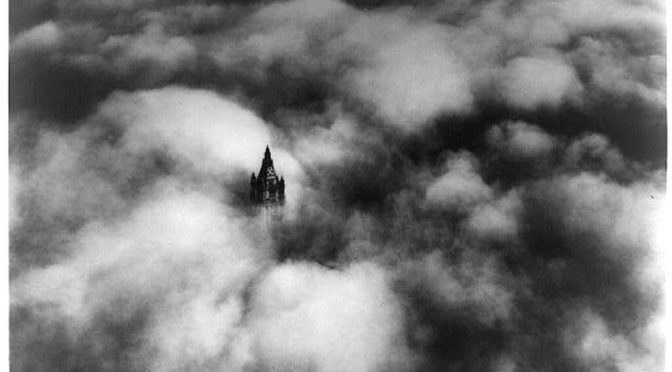
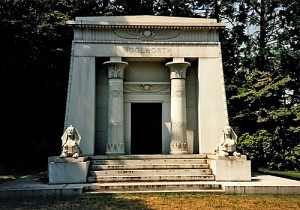
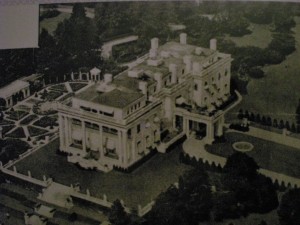
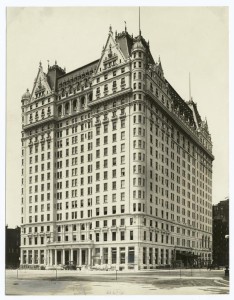
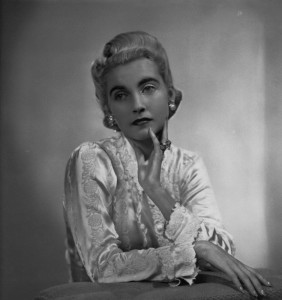
5 replies on “The many mysterious events that befell the Woolworths after constructing the Woolworth Building”
Shadow Lawn was built in Long Branch, New Jersey. It is now part of Monmouth University and has been named Wilson Hall for the mansion that stood there before Parsons built his and served as a summer white house for President Wilson. My son attended Monmouth University but I was previously familiar with Shadown Lawn/Wilson Hall, as many others would be because the 1982 movie Annie was filmed there. http://en.wikipedia.org/wiki/Shadow_Lawn_%28New_Jersey%29
The Woolworth’s chain in South Africa may carry the same name, but is actually unrelated to the US chain. In SA, they’re more upscale than the “five and dimes” here, and include grocery areas (but not lunch counters).
DOES A N Y O N E KNOW ANYTHING ABOUT RECENT GHOST SCARES? Some stuff’s been heavily happening on 18th floor after renovations this year.
Looking for John Manson, the first black man that was put on the training program in a philadelphia store around 1962.
I enjoyed a good lunch at a fair price at Woolworths in NYC. My fondest memory is of their pumpkin pie. That pumpkin pie slice(s) got me through some rough and tough times at work. That pie, store made or not, put a smile back on my face everytime and a couple of pounds around my waist. Those were the days.